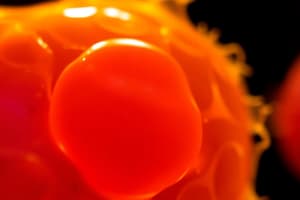Podcast
Questions and Answers
Which type of stem cell can develop into any human cell type, including the development from an embryo into a fetus?
Which type of stem cell can develop into any human cell type, including the development from an embryo into a fetus?
- Multipotential Stem Cell
- Pluripotential Stem Cell
- Totipotential Cells (correct)
- Unipotent Stem Cells
What is a characteristic of multipotential stem cells?
What is a characteristic of multipotential stem cells?
- They can develop into any cell type including a fetus.
- They produce specific types of cells for tissue formation. (correct)
- They are found in embryos only.
- They are the earliest type of stem cells formed.
During which stage of hematopoiesis is erythropoiesis confined to the blood islands of the yolk sac?
During which stage of hematopoiesis is erythropoiesis confined to the blood islands of the yolk sac?
- Fetal Stage
- Definitive Stage
- Mesoblastic Stage (correct)
- Hepatic Stage
At what point in gestation does hematopoiesis transition from the yolk sac to the fetal liver?
At what point in gestation does hematopoiesis transition from the yolk sac to the fetal liver?
Which type of hemoglobin is NOT present during mesoblastic hematopoiesis?
Which type of hemoglobin is NOT present during mesoblastic hematopoiesis?
At what stage of gestation does the bone marrow become the primary site of hematopoiesis?
At what stage of gestation does the bone marrow become the primary site of hematopoiesis?
What type of cells are primarily found in red bone marrow after birth?
What type of cells are primarily found in red bone marrow after birth?
Which of the following is NOT a primary site of hematopoiesis in adults?
Which of the following is NOT a primary site of hematopoiesis in adults?
What is the first step in hematopoietic cell generation and maturation?
What is the first step in hematopoietic cell generation and maturation?
What characterizes red marrow?
What characterizes red marrow?
Which type of cell is the earliest blast form of granulocytes?
Which type of cell is the earliest blast form of granulocytes?
What is the role of hematopoietic growth factors?
What is the role of hematopoietic growth factors?
How does the chromatin pattern change as a cell matures?
How does the chromatin pattern change as a cell matures?
Flashcards are hidden until you start studying
Study Notes
Types of Human Stem Cells
- Totipotential Cells:
- Present shortly after fertilization
- Most versatile, can develop into all human cell types, including fetus
- Pluripotential Stem Cells:
- Develop a few days post-fertilization
- Can differentiate into any cell type except fetal development
- Multipotential Stem Cells:
- Derived from pluripotential cells
- Found in adults, limited to forming specific cell types
- Example: Bone marrow produces various blood cells, cartilage, and adipose tissue
Stages of Hematopoiesis
- Mesoblastic Stage:
- Begins around the 19th day of gestation in yolk sac blood islands
- Active for 8-12 weeks, mainly focused on erythropoiesis
- Involves embryonic hemoglobin types: Gower 1, Gower 2, and Portland
- Hepatic Stage:
- Occurs in the 3rd month of gestation, shifting hematopoiesis to the fetal liver
- By the 4th month, primitive cells decrease as definitive erythroblast, granulocytes, and megakaryocytes emerge
- Spleen, thymus, and lymph nodes become active in hematopoiesis
- Hemoglobin present: Hemoglobin F, Hemoglobin A1, Hemoglobin A2
- Myeloid/Medullary Stage:
- Takes place between the 5th and 6th month of gestation as bone marrow becomes primary hematopoiesis site
- At birth, bone marrow is the dominant source of cell production
- Hematopoiesis happens in most bones, primarily in flat bones (e.g., sternum, ribs, vertebrae)
Bone Marrow Structure and Function
- One of the largest organs, consisting of hematopoietic cells, fat tissue, and stroma
- Red marrow: Active in cell production
- Yellow marrow: Contains fats, inactive in cell production
- Red marrow can regress into yellow marrow
- Marrow contains immature cells that mature into functional blood cells
Cellular Elements of Bone Marrow
- Pluripotential stem cells initiate hematopoietic cell generation and maturation
- Multipotential hematopoietic stem cells serve as the progenitor for all blood cells
Hematopoietic Cell Phases
- Primitive/Multipotential Cells:
- Most immature, capable of self-renewal and differentiation into all blood cells
- Intermediate Cells:
- Committed progenitor cells on the path to distinct lineages
- Mature Cells:
- Fully developed with specific functions, seen in peripheral blood
- Granulocytes include basophils, eosinophils, and neutrophils
Examination of Maturing Cells
- General cellular characteristics include overall cell size and nuclear-cytoplasmic (N:C) ratio
- Nucleus contains DNA and genetic information; chromatin changes from loose to clumped structure during maturation
- Cytoplasm stains basophilic (deep blue) indicating protein presence
- Hematopoietic growth factors (cytokines) stimulate or inhibit precursor cell production, including Colony Stimulating Factors (CSF) and Colony Forming Units (CFU)
Studying That Suits You
Use AI to generate personalized quizzes and flashcards to suit your learning preferences.



